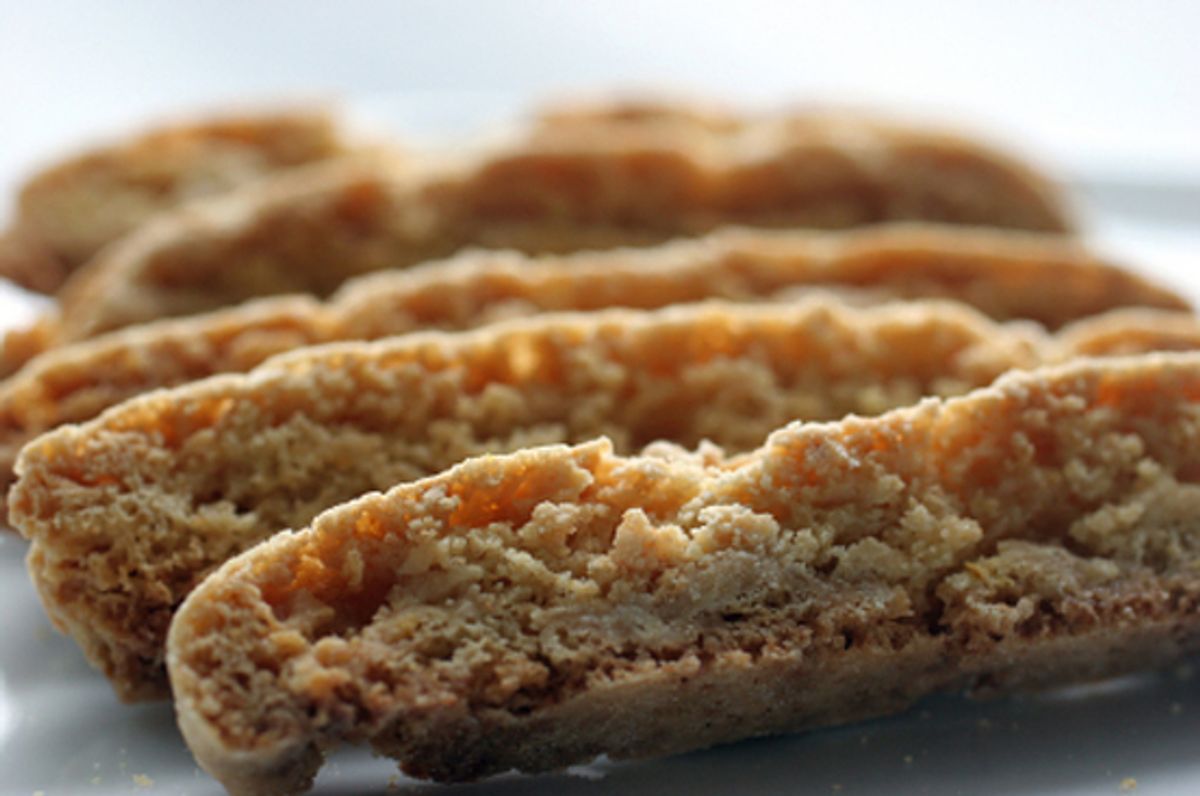I lost my newspaper job a little over a year ago. It was a job I loved, but a job that could, at times, leave my psyche stressed and my shoulders sore. Cradling a phone on one shoulder and hunching over a computer on deadline wreaks havoc on the back.
On incredibly wild days -- during elections, bad storms, huge fires, murders, wars -- I'd come home after deadline longing to do something simple, something soothing to work out my mental and physical kinks.
Sometimes I'd pull out the cookbook I inherited from my grandmother -- my Nonna -- a small, old volume stuffed with well-used scraps of paper stained with food and coffee and wine. The scraps contain her own recipes in her distinctive European script for everything from her giardiniera (green peppers, onions and tomatoes sautéed in olive oil) to polenta (the kind you have to stir for 45 minutes or else the kitchen god will smite you), to creamy risotto and various baked goods, including her favorite biscotti.
Then I would bake.
The delectable biscotti evolved over the years as moods, ingredients and bakers changed. That's the wonderful thing about biscotti: Once you get the basic recipe down pat, the sky's the limit for embellishing, my Nonna's forte.
My Nonna, born in the area now known as Friuli-Veneto Giulia, just outside Venice, found recipes too constraining. She treated them more like guides than formulas, and one could only hope to approximate her finished dishes. Whatever they lacked in consistency from time to time, they more than made up for in their celebration of what was fresh or on sale, and my Nonna's mood at that particular moment in time.
Always impeccably dressed in nylons and heels, her hair coiffed, her face rouged, she'd command the kitchen as if she were painting the Mona Lisa, her wooden spoon standing in for a paintbrush, her spices taking the place of her paints.
Her pasta sauce was far superior to anything "Americane," as she head-shakingly referred to the supermarket stuff, and she practiced her kitchen magic to music. Nonna especially loved jazz, and she’d hum along with Ella Fitzgerald and Frank Sinatra while she created her culinary masterpieces.
If she was in the mood to bake, it was always biscotti, and we'd prepare the dough together, doing everything the "right way," like in the old country. There were no electric mixers ("Americane"); we'd mix and stir using her wooden spoon. Then we'd flour our hands and go to work forming the dough into logs on her well-worn baking sheets.
Then, we popped the logs into the oven for the first baking. The kitchen of her little bungalow in Detroit smelled like Italian heaven. While the logs cooled, Nonna would make us coffee, hers strong with just a splash of milk; mine, mostly heated milk with just a splash of coffee.
Then we'd slice the logs and return the biscotti to the oven for the second baking, designed to dry them so they soak up the vino or caffe.
These days, I find myself baking more out of frustration than for relaxation. There are no jobs for middle-aged middle managers at newspapers; my days as a managing editor are done. I've come to terms with that and I'm refashioning myself.
But just like writing, baking feeds my soul. I am perpetually awestruck that a few basic ingredients -- or words -- can be combined, kneaded and transformed into something wonderful, food both for thought and for my soul.
I found myself in the kitchen late last night, restless and looking for something to soothe me. With the radio playing softly so as not to wake the rest of the house, I gave thanks for the happy times I spent with my Nonna in the kitchen, and I baked.
Nonna's Basic Biscotti Recipe
½ pound (2 sticks) unsalted butter, softened
2 cups sugar
4 eggs
½ tablespoon baking powder
1 tablespoon vanilla
2 tablespoons anise seed
¾ cup chopped almonds
4 cups unbleached all-purpose flour
- Preheat oven to 350 degrees.
- Mix butter, sugar, eggs, baking powder, vanilla, anise seed and almonds until well blended.
- Add in flour gradually and stir. The dough will be sticky, but not difficult to handle.
- (I was in the mood for cranberry pistachio biscotti last night, so I added ¾ cup dried cranberries and ¾ cup pistachios to the dough after all the other ingredients were mixed together.)
- Make 2 logs about 12 inches long and 4 inches wide.
- Bake 40-45 minutes on a baking sheet with sides or in a biscotti pan* (which will hold one log or half the recipe) or another kind of rectangular baking pan. The sides on the pan or sheet are important because they keep the sides of the biscotti from burning.
- Remove the loaves from the oven and allow to cool.
- When cool, cut each into 1-inch slices.
- Place slices back on baking sheet; bake another 10-15 minutes until golden.
It’s important to let the loaves cool before slicing -- it makes a world of difference in the appearance of the biscotti and keeps the slices from breaking apart.
*I have become a biscotti pan convert and use two of them for this particular recipe. The advantage is that the pan contains the logs from spreading and assures a more uniform size.



Shares